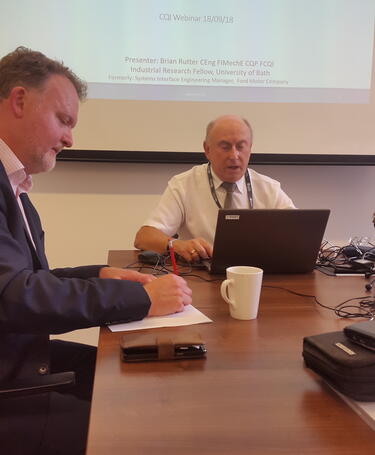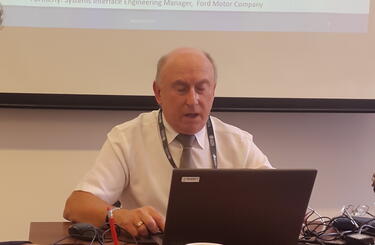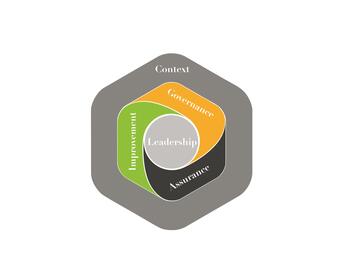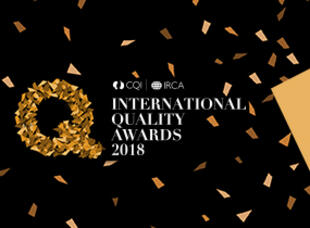
Innovation: the great opportunity
Progress indicator

The CQI’s fifth Corporate Connect event of the year explored how human design thinking can encourage successful innovation.
The fifth Corporate Connect event of the year was delivered as a live webinar from the CQI’s headquarters in London on 18 September. During the broadcast, Brian Rutter, CQP FCQI, Industrial Research Fellow, University of Bath (formerly Systems Interface Engineering Manager at Ford Motor Company), explored how the CQI’s Competency Framework, interpersonal skills and the impact of ambiguity on management styles can support successful innovative teamwork.
In his 38 years with Ford Motor Company, Rutter undertook multiple assignments, including a sustainable global innovation process which comprises human-centred design, all aspects of innovation, system integration and interpersonal skills.
Rutter said this project required him to ask how interpersonal skills and innovation can merge to leverage the best from employees. He explained innovation as the implementation of a new or significantly improved product, service or process that creates value for business, government or society. “The key word is ‘value’,” he said. “Innovation is about bringing those value propositions to a business or society.”
Crucial to innovation is curiosity and creativity. Rutter said creativity allows us to perceive the world in new ways, find hidden patterns and generate solutions we hadn’t thought of before. Curiosity, he argued, allows organisations to really understand their customers by questioning their needs. “If I am curious it means I am not making judgements, I am not evaluating, I am not biased. I’m curious to open my mind to ideas and thoughts,” he said. “Human design thinking uses visualisation to understand, explore and experiment to better understand the end user and bring value to their lives. It encourages curiosity to enable a customer-focused empathetic strategic observation.”
Competency Framework

Using the Competency Framework, Rutter explored how context, governance, assurance, improvement and leadership connect to innovation.
He asked participants of the virtual session which areas of expertise were becoming essential beyond current and past customer enquiry processes. A large majority voted for adjacent technologies (55%), 27% voted for psychology, while early adopters and social science received 9% of votes each and political science had zero votes from participants.
Rutter said political and social scientists are crucial to understanding whether the political process can add value to an organisation and explain societal trends. He said psychology is about a new way of thinking and sharing without judgement. Early adopters, he argued, reveal opportunities and adjacent technologies provide intuitive interaction.
In order to understand what opportunities are available, Rutter introduced the micro and macro spheres. The micro sphere can help an organisation focus on the individual by looking at the behaviours we exhibit, our changing environment, culture, acceptability in society, and ideology. The macro sphere looks at political changes, new technologies, social drift, and also economic opportunities.
“How does the macro and micro world interact together?” Rutter asked participants. “You can maximise the potential opportunity combinations by combining individual attributes with the societal attributes. You take all this information and you may decide there’s something specific you want to look at. Absorb what you see and hear so you can learn from customer experience.”
A strong culture aligned to strategy and leadership can deliver positive organisational outcomes
Using the Know-Make framework created by Professor Vijay Kumar, Dean at Penn Engineering Ohio State University, Rutter shared how organisations can establish stakeholder needs to ensure good governance. The first step is to consider the world around us and establish the initial problem. The next step is to gather insights from research and observations to better understand the end user and stakeholders. After conducting research, organisations should organise the data to establish patterns and identify opportunities. “Using this method, from a quality point of view, allows you to trace back your thinking,” Rutter said.
When managing innovation, if ambiguity is low it is possible to quickly recognise the goals and opportunities, but this can result in identifying solutions too quickly and system integration opportunities could be missed. When ambiguity is high, Rutter argued that managers need to prioritise flexibility as multiple issues and actions must be considered simultaneously.
To address assurance in the presence of ambiguity, Rutter highlighted the importance of defining the value proposition, identifying high-level risks and considering the wider implication of any opportunity.
Continuous improvement can also be achieved by reviewing the performance of the current solution, creating new value propositions, developing new customer solutions and reducing risks.
“In an innovative organisation, learning is important,” Rutter said. Participants agreed as 40% voted for learning when asked which business attribute is the most important for a successful, innovative business. Rutter said a strong culture aligned to strategy and leadership can deliver positive organisational outcomes by driving employee engagement and empowerment.
Key takeaways
Participants learned that engaging the full capability of teams and individuals and empathetic understanding of end users are the keys to successful innovation.
Neil Mellor, CQP FCQI, Group Quality Assurance Manager at NG Bailey said: "Brian really showed how the softer, relationship management and leadership skill set is vital to the successful achievement of rapid innovation. I never realised that having fun while doing your work was such a key part of the process."
Vincent Desmond, CEO at the Chartered Quality Institute said: “We really appreciated Brian sharing his extensive experience in the automotive sector implementing the framework, culture and cross-disciplinary teams required to drive and de-risk innovation.Certainly, the key takeaway for me is that innovation is not a project, it’s a framework and a culture.”
Quality World

Get the latest news, interviews and features on quality in our industry leading magazine.



